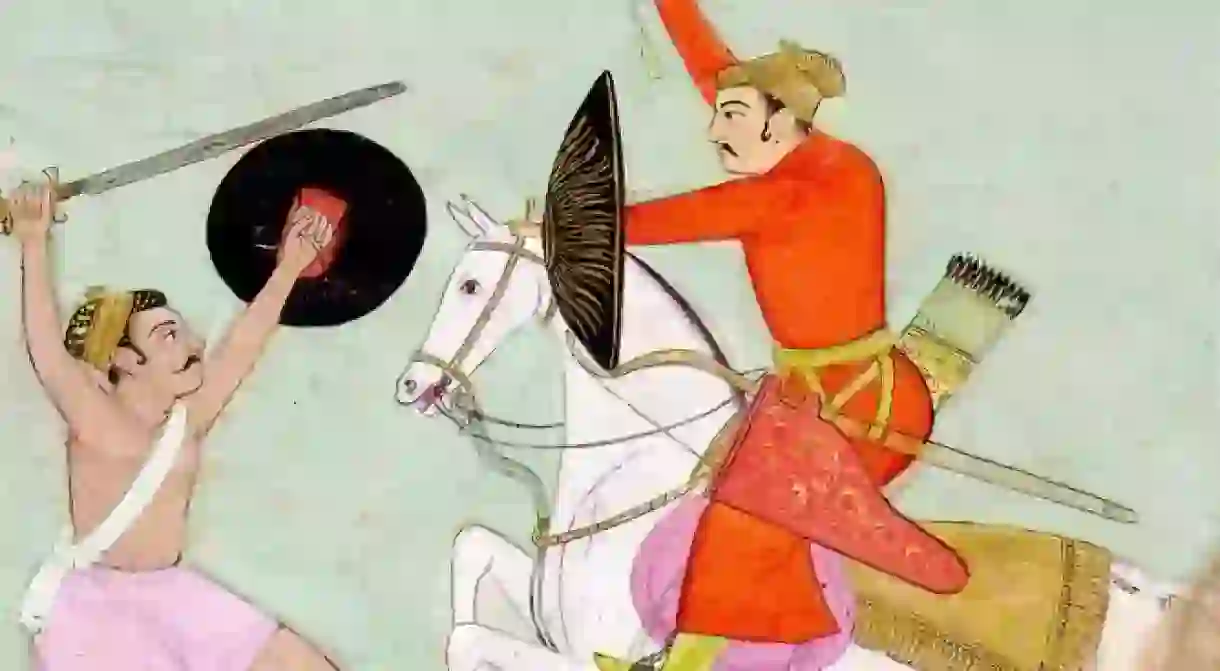Nat Ragini And The Ragamala Paintings Of Mughal India

The classical imagery of Nat Ragini evokes the history and society of Mughal India, whilst reflecting the Ragamala tradition, in which musical modes were given visual representations. These paintings, as Rajesh Punj suggests, illustrate the refined culture of the Rajput and Mughal courts at a time of epochal change.

Nat Ragini
This example of Nat Ragini is an opaque watercolour work; circa. 1690 – 1710, with gold highlights on polished paper. It is a vibrant depiction of a mounted warrior, of senior rank, clothed in elaborate dress and fine weaponry, in combat with a near naked foot-soldier. A thin wash of light blue and green depict an undulating landscape, and a wisp of deeper blue suggests a turbulent sky; the scene appears to be the attempt of a court artist to capture this heroic moment at the height of battle. This meticulous depiction by a loyal courtier can be likened to the work of a war photographer assigned to cover the dark days of conflict.
Pictorially the lead protagonist’s white horse rises up in haste, enraged by the unsettling scene of brutal combat. The seated swordsman appears to unsheathe his decorated sword before an exposed foot-solider who is scarcely dressed in loin cloth and slippers, carrying a shoulder bag or ceremonial ribbon over his shoulder. The standing figure pushes his shield up into the air, turning his sword in the direction of the horseman, anticipating – yet not depicting – the awful moment of collision.
In the foreground of the work, a fallen figure is splayed out, be-headed on the rock. Upon closer inspection, this decapitated figure appears to have had his headdress and shoes torn from him, depicting what might have been the even greater humiliation of having been stripped of rank and regiment, before a violent dismemberment.
The decapitated figure appears to represent an earlier part of the battle as the landscape is very different. An uneven stretch of blue mountain is enclosed in the foreground as an alternative scene to the more open landscape that dominates the work; together these are suggestive of a newfound sophistication at depicting a sequence or a series of events over the course of a period of time, foreshadowing the techniques of animation.

Ragamala Paintings
Nat Ragini is from a set of Ragamala paintings that date back to the 16th and 17th century. These were originally an integral part of the school of Indian painting. They illustrate various musical modes, (ragas) with a stock range of images that were commissioned to depict different aspects of the lives of the court; including such scenes of two women garlanding a deity on open waters. Other scenes are of an elegant regal figure crossed-legged on a beautiful Garden of Eden, with a young courtesan, a woman in a stylised landscape; and in another, a Maharajah and his courtesan are both perched together on a cushioned swing.
The Ragamala series were prized for their narrative as well as the visual effect of their use of rich, vibrant colours. Artists tended to use a warm palette of blue, red, white and golden yellow to depict military expeditions, hunting scenes and great dynastic ceremonies of marriage.
Collectively these exquisite watercolours recall fables, retold through the musical mantra of song in this glorious extended era of Indian history, which was as much revered as it was unruly. These templated opaque watercolours would have been collected as an elaborate visual manuscript or private diary.
Sangeeta Ratnakara, one of the most significant musicological texts from India, is an important 12th century treatise on the classification of Indian Ragas, which for the first time mentions the presiding deity of each raga. From the 14th century onwards, they were described in short verses in Sanskrit, for Dhyana, ‘contemplation’, and later depicted in a series of paintings, called the Ragamala paintings. Some of the best available works of Ragamala are from the 16th and 17th centuries, when the form flourished under royal patronage. The form gradually faded during the 19th century as patronage dwindled alongside the fortunes of the royal house.














